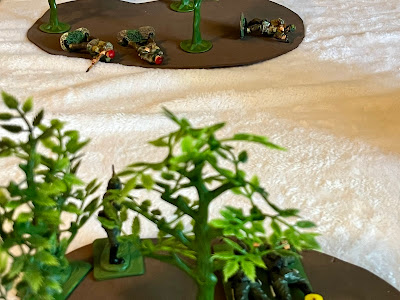Over the weekend, I set up trying to settle on a set of rules for the North Pole games. There were quite a lot in contention, but the top contenders for this experiment were: One Brain-Cell Toy Soldiers (1BC) with card-based unit activation, G.A.S.L.I.G.H.T. with half-sized units, and One Hour Skirmish Wargames(OHSW).
For the scenario, a German platoon of three 5-man sections, one HMG, one light mortar and a platoon leader is advancing to capture some buildings on the outskirts of Christmas Village. An under-strength platoon of British paras, consisting of two 5-man sections, an HMG, and a platoon leader, move into the area to hold off the German advance. The Germans win if they capture both buildings, otherwise it's a win for the British.
You can tell this is non-canonical as I didn't break out my dozens of Christmas trees for the woods.
The fact that the pictures below tell a cohesive story is completely by accident. They are from multiple games.
 |
| British occupy the ruined building on their left. |
 |
| "Knock! Knock!" |
 |
| British assault the house. |
 |
| The Germans hold the farm house, and the defenders of the other building are defeated in close assault. |
 |
| Things take a turn for the worse on the British right. |
 |
| Game over. This is most likely from the OHSW game, as contact with a downed figure is immediate figure removal. |
I'm not sure I'm any further along in deciding.
I *can* say that, while it's no secret I love OHSW,, 18 units (the Germans, each figure or weapon team is a unit) on one side really felt like it was straining the system.
The action felt less chaotic whirlwind and more disjointed than usual. At best you can take action with 13 units, and more often than not less than that. If you want to move and shoot with each figure even drawing a King, you're looking at 6 figures taking action. To make it work, I'd have to drop one of the 5-man sections or support weapons or some similar combination (never mind that I have tanks, half-tracks, PAK-38s etc. for the Germans to use at the North Pole).
Both GASLIGHT and OHSW handle characters and vehicles easily - so a coin flip there.
GASLIGHT requires some adjustments for the under-sized units: morale and Shoot values primarily. Morale is somewhat silly in GASLIGHT, which I love, but maybe not for WWII troops (definitely would use for woodland creatures, elves, etc.).
1BC wins for simplicity and adding card activation made it more like GASLIGHT. There's no vehicle rules so they require improvising - nothing I haven't done before, and I could probably bolt on either of the others in some way, but still, it's extra work.
I really like the Force Motivation and Force-level Morale check in OHSW as opposed to individual unit morale checks in GASLIGHT or 1BC. Although, this was the first time I ever came close to a side failing their morale check - the paras lost their PL (a Leader(3) in OHSW terms) and only had their section leaders (Leader(1) in OHSW terms). They came within 1 point of failing their morale check.
So, each set has things that work, and things that work sort-of. And I like them all.
Maybe I'll just choose whichever one I'm feeling on the day? Or maybe, more play tests are in order? Oh darn.
















